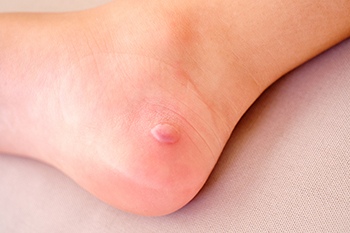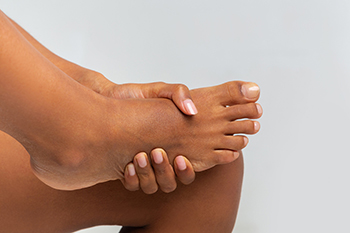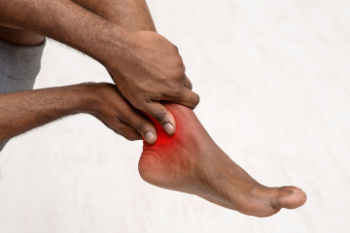Items filtered by date: July 2024
Caring for Blisters on the Foot

There are many causes for blisters, which are small sacs of fluid that form on the body. One of the main causes of blisters on the feet is new, tight, or ill-fitting shoes. The harder areas of the shoe can rub against your heels, soles, and toes, and if the motion is repeated for long periods, blisters often will form. These become very painful, especially if you continue the activity. Excessive moisture or perspiration, more often in warmer weather, also may cause blisters. There are a few precautions you can take to prevent blisters. Keeping the feet dry and putting powder on them to reduce sweating, and wearing moisture-wicking socks can help. Wearing softer, more flexible shoes can reduce the chances of blister formation, and reducing your activity for a few days will allow them to heal on their own. If a blister pops open, is extremely large, or won’t heal, it is suggested that you seek the professional care of a podiatrist who can safely drain the area and help reduce the chance of infection.
Blisters may appear as a single bubble or in a cluster. They can cause a lot of pain and may be filled with pus, blood, or watery serum. If your feet are hurting, contact Paul A. Santangelo, DPM of Illinois. Our doctor can provide the care you need to keep you pain-free and on your feet.
Foot Blisters
Foot blisters are often the result of friction. This happens due to the constant rubbing from shoes, which can lead to pain.
What Are Foot Blisters?
A foot blister is a small fluid-filled pocket that forms on the upper-most layer of the skin. Blisters are filled with clear fluid and can lead to blood drainage or pus if the area becomes infected.
Symptoms
(Blister symptoms may vary depending on what is causing them)
- Bubble of skin filled with fluid
- Redness
- Moderate to severe pain
- Itching
Prevention & Treatment
In order to prevent blisters, you should be sure to wear comfortable shoes with socks that cushion your feet and absorb sweat. Breaking a blister open may increase your chances of developing an infection. However, if your blister breaks, you should wash the area with soap and water immediately and then apply a bandage to the affected area. If your blisters cause severe pain it is important that you call your podiatrist right away.
If you have any questions, please feel free to contact our offices located in Niles and Rockford, IL . We offer the newest diagnostic and treatment technologies for all your foot care needs.
Symptoms and Treatment of Achilles Tendon Injuries
 Achilles tendon injuries are prevalent among people who engage in physical activities, from athletes to casual exercisers. The Achilles tendon, which connects the calf muscles to the heel bone, is critical for movements like standing on toes and propelling forward when walking or running. Common injuries include Achilles tendinopathy, which involves tiny tears from overuse and results in pain, swelling, and morning stiffness. More severe Achilles tendon injuries, such as partial or complete tears, cause sudden, sharp pain, swelling, and difficulty pointing the foot down or standing on tiptoe. A podiatrist can diagnose these injuries through a physical exam, ultrasound, X-rays, or MRI scans to assess the extent of damage. Treatment depends on the injury's severity. Mild cases may be managed with rest and stretching exercises, while severe tears might require surgery and immobilization with a cast or brace. If you are experiencing pain resulting from an Achilles tendon injury, it is suggested that you schedule an appointment with a podiatrist for an exam, diagnosis, and treatment options.
Achilles tendon injuries are prevalent among people who engage in physical activities, from athletes to casual exercisers. The Achilles tendon, which connects the calf muscles to the heel bone, is critical for movements like standing on toes and propelling forward when walking or running. Common injuries include Achilles tendinopathy, which involves tiny tears from overuse and results in pain, swelling, and morning stiffness. More severe Achilles tendon injuries, such as partial or complete tears, cause sudden, sharp pain, swelling, and difficulty pointing the foot down or standing on tiptoe. A podiatrist can diagnose these injuries through a physical exam, ultrasound, X-rays, or MRI scans to assess the extent of damage. Treatment depends on the injury's severity. Mild cases may be managed with rest and stretching exercises, while severe tears might require surgery and immobilization with a cast or brace. If you are experiencing pain resulting from an Achilles tendon injury, it is suggested that you schedule an appointment with a podiatrist for an exam, diagnosis, and treatment options.
Achilles tendon injuries need immediate attention to avoid future complications. If you have any concerns, contact Paul A. Santangelo, DPM of Illinois. Our doctor can provide the care you need to keep you pain-free and on your feet.
What Is the Achilles Tendon?
The Achilles tendon is a tendon that connects the lower leg muscles and calf to the heel of the foot. It is the strongest tendon in the human body and is essential for making movement possible. Because this tendon is such an integral part of the body, any injuries to it can create immense difficulties and should immediately be presented to a doctor.
What Are the Symptoms of an Achilles Tendon Injury?
There are various types of injuries that can affect the Achilles tendon. The two most common injuries are Achilles tendinitis and ruptures of the tendon.
Achilles Tendinitis Symptoms
- Inflammation
- Dull to severe pain
- Increased blood flow to the tendon
- Thickening of the tendon
Rupture Symptoms
- Extreme pain and swelling in the foot
- Total immobility
Treatment and Prevention
Achilles tendon injuries are diagnosed by a thorough physical evaluation, which can include an MRI. Treatment involves rest, physical therapy, and in some cases, surgery. However, various preventative measures can be taken to avoid these injuries, such as:
- Thorough stretching of the tendon before and after exercise
- Strengthening exercises like calf raises, squats, leg curls, leg extensions, leg raises, lunges, and leg presses
If you have any questions please feel free to contact our offices located in Niles and Rockford, IL . We offer the newest diagnostic tools and technology to treat your foot and ankle needs.
How Does Multiple Sclerosis Affect Foot Health?

Multiple sclerosis, or MS, can significantly impact foot health due to its effects on the nervous system, leading to various symptoms. Common foot issues can include numbness or tingling, muscle weakness, and difficulty with balance and coordination. These symptoms can contribute to challenges in walking, increased risk of falls, and potential development of foot deformities like claw toes or foot drop. Managing MS-related foot issues involves a multidisciplinary approach, with visiting a podiatrist as an essential part. Podiatrists can assess foot function, and recommend appropriate footwear to improve stability and reduce pressure points. Regular podiatric care helps individuals with MS maintain optimal foot health, minimizing discomfort and improving mobility. If you have multiple sclerosis, it is suggested you visit a podiatrist who can help you manage this condition as it affects your feet.
Some foot conditions may require additional professional care. If you have any concerns, contact Paul A. Santangelo, DPM of Illinois. Our doctor can provide the care you need to keep you pain-free and on your feet.
Rare Foot Conditions
The majority of foot conditions are common and can be treated by a podiatrist. Standard diagnostic procedures are generally used to identify specific conditions and treatment can be rendered. A podiatrist also treats rare foot conditions which can be difficult to diagnose and may need extra attention and care.
There are many rare foot conditions that can affect children. Some of these can include:
- Freiberg’s disease
- Kohler’s disease
- Maffucci syndrome
Freiberg’s disease - This can be seen as a deterioration and flattening of a metatarsal bone that exists in the ball of the foot. It typically affects pre-teen and teenage girls, but can affect anyone at any age. Symptoms that can accompany this can be swelling, stiffness, and the patient may limp.
Kohler’s disease - This often targets the bone in the arch of the foot and affects younger boys. It can lead to an interruption of the blood supply which ultimately can lead to bone deterioration. The patient may limp or experience tenderness, swelling, and redness.
Maffucci syndrome - This affects the long bones in a child’s foot leading to the development of abnormal bone lesions. They are benign growths and typically develop in early childhood and the bones may be susceptible to breaking.
A podiatrist can properly diagnose and treat all types of rare foot conditions. If your child is affected by any of these symptoms or conditions, please don’t hesitate to call our office so the correct treatment method can begin.
If you have any questions please feel free to contact our offices located in Niles and Rockford, IL . We offer the newest diagnostic tools and technology to treat your foot and ankle needs.
4 Stages of Osteoarthritis and Its Impact on the Feet

Osteoarthritis progresses through four stages, each affecting the feet differently. In the early stage, the cartilage in the joints begins to wear down, causing mild pain and stiffness in the feet, often after physical activity. As the condition advances to the moderate stage, the cartilage damage worsens, leading to increased discomfort, swelling, and difficulty in moving the toes and ankles. The severe stage of osteoarthritis is characterized by significant cartilage loss, resulting in constant pain, inflammation, and reduced mobility. In the final stage, the cartilage is almost completely worn away, causing intense pain, deformities, and a drastic decrease in function. This progression impacts daily activities, emphasizing the need for early intervention. If your feet are affected by this type of arthritis, it is suggested that you consult a podiatrist who can help you to manage this condition.
Arthritis can be a difficult condition to live with. If you are seeking treatment, contact Paul A. Santangelo, DPM from Illinois. Our doctor can provide the care you need to keep you pain-free and on your feet.
Arthritic Foot Care
Arthritis is a joint disorder that involves the inflammation of different joints in your body, such as those in your feet. Arthritis is often caused by a degenerative joint disease and causes mild to severe pain in all affected areas. In addition to this, swelling and stiffness in the affected joints can also be a common symptom of arthritis.
In many cases, wearing ill-fitting shoes can worsen the effects and pain of arthritis. Wearing shoes that have a lower heel and extra room can help your feet feel more comfortable. In cases of rheumatoid arthritis, the arch in your foot may become problematic. Buying shoes with proper arch support that contour to your feet can help immensely.
Alleviating Arthritic Pain
- Exercises that stretch the foot can prevent further pain and injury and increase mobility
- Most of the pain can be alleviated with anti-inflammatory drugs, heat, and topical medications
- Massages can help temporarily alleviate pain.
It is best to see your doctor for the treatment that is right for your needs and symptoms. Conditions vary, and a podiatrist can help you determine the right method of care for your feet.
If you have any questions, please feel free to contact our offices located in Niles and Rockford, IL . We offer the newest diagnostic tools and technology to treat your foot and ankle needs.
Let the Expert Treat Your Ingrown Toenails
What Does Diabetic Limb Salvage Mean?

Diabetic limb salvage is a medical approach focused on preventing amputations in patients with diabetes. Diabetes can lead to poor circulation and nerve damage, particularly in the lower extremities, increasing the risk of severe infections and ulcers. Limb salvage involves a comprehensive treatment plan aimed at healing these ulcers, improving blood flow, and managing infections. This multidisciplinary approach includes wound care, surgical interventions, and lifestyle modifications to control blood sugar levels and enhance overall foot health. The goal is to preserve the patient's limbs, improve quality of life, and prevent the devastating impact of amputation. Timely intervention and continuous care are essential to the success of diabetic limb salvage, emphasizing the importance of regular medical check-ups and early treatment of any foot issues in diabetic patients. If you have diabetes, it is strongly suggested that you are under the care of a podiatrist who can evaluate your condition, and educate you about methods that may help to avoid amputation.
Diabetic Limb Salvage
Diabetic limb salvage can be an effective way in preventing the need for limb amputation. If you have a foot ulcer and diabetes, consult with Paul A. Santangelo, DPM from Illinois. Our doctor will assess your condition and provide you with quality foot and ankle treatment.
What Is Diabetic Limb Salvage?
Diabetic limb salvage is the attempt of saving a limb, such as the foot, that has an infected ulcer, from amputation. Podiatrists also try to make sure that there is enough function in the foot after the salvage that it is still usable. Those with diabetes experience poor blood circulation, which prevents proper healing of an ulcer. If the ulcer is left uncheck, it could become infected, which could result in the need for amputation.
Diabetes is the number one cause of non-traumatic amputations in the United States. Amputation has been found to lead to higher mortality rates. This translates into higher healthcare costs, and a reduced quality of life and mobility for amputees. Podiatrists have attempted to increase the prevalence of limb salvage in an attempt to solve these issues.
Diagnosis and Treatment
Limb salvage teams have grown in recent years that utilize a number of different treatments to save the infected limb. This includes podiatrists that specialize in wound care, rehabilitation, orthotics, and surgery. Through a combination of these methods, limb salvage has been found to be an effective treatment for infected limbs, and as an alternative to amputation. Podiatrists will first evaluate the potential for limb salvage and determine if the limb can be saved or must be amputated.
If you have any questions, please feel free to contact our offices located in Niles and Rockford, IL . We offer the newest diagnostic and treatment technologies for all your foot care needs.

